EV Pusher Archive Page Three
EV Pusher Project
Archive page Three
|
What? |
March 23, 2001. A red-letter Friday. Not content with the weather forecast for the weekend ("showers likely"), I decided to try out the pusher on nearby residential streets in second and third gear. It must have been quite a sight, as I turned many heads while billowing huge clouds of blue smoke until the engine got warm and all of the unburned fuel from many failed stating attempts in the past burned out of the muffler!
From what I could tell, there isn't much of an affect on the EV when the clutch engages on the pusher, you can just feel a little surge in the car's motion. Cranking open the throttle then causes the diesel to begin pushing, and I can watch the EV's ammeter drop, then go into regenerative braking as the car picks up speed. Of course, 2nd and 3rd gear on the pusher is only about 25 and 40 MPH, respectively at moderate RPM's, but this was enough for residential streets with cross traffic and pedestrians.
From this test, I have concluded so far that it's possible to engage and disengage the clutch without causing the car to lurch, lag or leap, and the acceleration seemed to be smooth and progressive, same with deceleration. At 40MPH on fairly straight smooth pavement, there was no discernable affect on the EV's steering or handling. In fact, it didn't feel any different from when the car is being driven by the electric motor, except for the eerie feeling of being under power while holding the clutch (on the EV) to the floor. There wasn't even very much engine noise that I could hear, but then I was pretty busy making sure that I wasn't going to drive right up the back of the car in front of me in case it slowed unexpectedly.
I do have some small fix-ups, there are a couple of minor coolant leaks, and I couldn't find any sticky- back Velcro to attach the controller to the dashboard. The clutch actuator switch is exactly backwards of what is intuitive, up is disengage, and down is engage. I'll fix that before I take the pusher out next time.
Next step... If it doesn't rain all weekend, I'll put the pusher in fourth gear and get up on the freeway, and open this baby up! 65MPH, here I come!!!
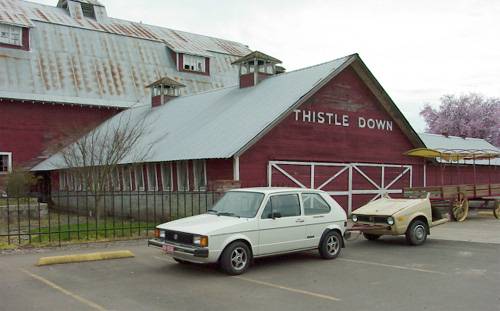
Mar 24th. In spite of forecasts for rain, and a few sprinkles on the windshield, I decided I couldn't resist getting the pusher out on the open road in fourth gear for a real test. Headed out of town on River Road, past the last of the condos and into fertile farmland and past rural produce stands, such as the quaint scene above.
What I found was that I could engage the pusher clutch at any speed over about 20, and accelerate from there, with or without significant assistance from the electric drive motor in the EV.
On the way north (out of town), I ran the car and pusher as a parallel hybrid, that is, both the diesel and electric motors engaged and driving the car forward. As I was stuck behind some slow (45MPH) traffic, I busied myself with experimenting with the throttle control on the pusher, trying combinations of diesel and EV power. The various combinations include: using partial electric and diesel power; diesel power alone by backing off the EV throttle until the E-meter showed 0 amps, with the diesel throttle set to the speed I wanted; and battery charge mode, accomplished by setting the diesel throttle higher than needed to hold the speed, and then backing off on the EV throttle even more, so that it went into regenerative braking.
I stopped at the railroad bridges near the end of Love Lake Road to check the diesel, investigate a slightly hot odor I detected, and turn around. Never did find out what the odor was. It might be from the Rabbit's fuel gauge, which I am using as a temperature gauge for the diesel. This hasn't worked as a battery state-of-charge indicator since I've had the car, so maybe it just needed to burn out some spider webs or something.
On the way home, I ran the pusher as stand-alone, engaging the clutch when the car reached 20MPH, then putting the EV transmission in neutral and allowing the diesel to provide all of the power. This worked well, with steady, but not astounding acceleration all the way up to 60MPH, which is where I chickened out. River Road is only two lane, and has cross-traffic. I'll save the high speed heroics for the interstate at a later date.
Getting on the freeway to go home, I decided to try some full throttle acceleration, using both the diesel and electric drives running flat-out. It wasn't really enough to require wheelie bars, but I was able to merge with the 55+MPH traffic smoothly on an uphill onramp.
Still no anomalous handling problems to report. The car behaves just as it should, as if the pusher wasn't even there. I was able to hear the engine, but it's not loud, what with the road noise inside the car. When I get the control and trailer lights cables fed into the car with connectors instead of running through the unlatched hatch-back door, it will be quieter still. I also have my eye on a heavily insulated hood from a diesel at the junkyard. More acoustic deadening.
Mar 29th. A teeny update on not much being done. I've working way too much on way too little sleep for the last few weeks, and now I'm feeling strung out and fatigued. In what few spare minutes I could work into the pusher, I installed a couple of new circuits into the controller. One circuit monitors that glow plug power and flashes the indicator light while the power is still flowing after the timing cycle has ended. I've been having bad results using the glow plug light to time the wait before starting the engine. The lamp goes off before the power to the plugs stops, so the new circuit will allow me to wait 5 -10 seconds more until starting the engine, while being assured that the plugs are still heating. Hopefully, this will get me more reliable starts.
The other circuit is an automatic reset for the AC inverter that runs the clutch motor. I found out that the inverter goes into overload when the battery voltage sags under starting load. I've gotten caught a couple of times with no way to engage the clutch because the inverter is in error mode, so now it gets reset when the oil pressure light extinguishes after the engine starts. Should solve the problem for good.
I've been thinking about my desire to use an automatic transmission on the pusher, and considering my experiences with the manual transmission so far. The clutch actuator built into the pusher seems to work very well, and I've yet to experience any problems associated with the manual transmission, such as bucking, unexpected deceleration, additional unwanted load on the EV before the diesel begins to supply power, etc. All in all, I think I can live with the pusher's manual transmission. The main reason for wanting an automatic was to make the conversion easier to do, but now that all of the mechanical and electronic interfaces are built, I'm inclined to try it out for a while and see if I even need the AT. I'll have more power and better fuel economy with a stick, and if the hill-climbing ability is within reason, I don't see any reason to have to downshift while under way, so the manual may just stay.
I do know where there is an '83 rabbit 4-door with an AT. I'll call about that tomorrow, if it can be had cheaply, I'll probably get it. It's time to get the body panels I need to make this project a bit more ship-shape, and if I buy a whole car, this saves me the bother of scouring wrecking yards for a hood, tail lights, etc. Also coming up is a new battery that will fit inside the engine compartment, some less ratty tires, fitting the original fuel tank into the body, and finally, the Rabbit rear end in place of the curved sheet metal. Oh, and I have just gotta get caught up on some sleep.....
 March 30th. The big news of the day is that the pusher has a new blue hood. Yeah, big whoop, but this is the first step towards getting the body work completed, and making the trailer weather resistant, so I don't have to hide it under plastic and tarps. This hood doesn't have big holes from the vandalism, and it has a thick sound-absorbent mat attached to the underside. While I was at the wrecking yard, I also picked up a manual (as opposed to cable-operated) hood latch, a rear hatch unit (the original is bent and damaged beyond repair), replacement tail and side marker lamps, and pocketfuls of small, free parts for both the pusher and the EV. Also checked out used tires, of which there were many that still have good tread, and even found an automatic transmission for $100, although I don't know if I even want it now.
March 30th. The big news of the day is that the pusher has a new blue hood. Yeah, big whoop, but this is the first step towards getting the body work completed, and making the trailer weather resistant, so I don't have to hide it under plastic and tarps. This hood doesn't have big holes from the vandalism, and it has a thick sound-absorbent mat attached to the underside. While I was at the wrecking yard, I also picked up a manual (as opposed to cable-operated) hood latch, a rear hatch unit (the original is bent and damaged beyond repair), replacement tail and side marker lamps, and pocketfuls of small, free parts for both the pusher and the EV. Also checked out used tires, of which there were many that still have good tread, and even found an automatic transmission for $100, although I don't know if I even want it now.
Of course, the pusher attracted a lot of attention in the wrecking yard parking lot, and I ended up giving 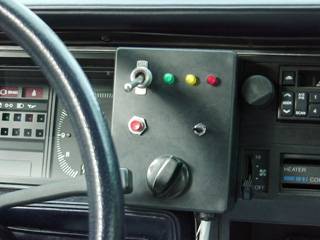 tours to interested customers for about half an hour before I could get away and get back to wrenching used parts.
tours to interested customers for about half an hour before I could get away and get back to wrenching used parts.
Before setting out in the morning, I used some self-stick knobby gripper material to attach the controller head to the dash, just within reach of my right hand while it rests on the steering wheel. This makes controlling the throttle and clutch much easier than when the controller was sitting on the passenger seat, and any passengers I carry will probably appreciate it too!
Today, I tried bump starting the engine by letting out the clutch while the car was in motion, rather than using the starter. This is the first time I've felt any roughness from the trailer. It kind of caused the EV to decelerate, then more or less jumped forward a bit when the engine started. Nothing too dramatic, but compared with the mild disposition I've experienced during the other trials, it was 'different'. I also found out what happens when you accidentally engage the clutch on the pusher while standing still. As expected, the engine dies, nothing more.

So, the tail end of this update is that I now have a cool chrome tip on the end of my exhaust pipe. Custom!
 The Latest, as of April 3rd. Work, Rain, Income Taxes. Also used some time between storms yesterday to install a new trailer light connector on the EV, along with a 24 conductor AMP connector for the controller circuitry. These installed very neatly behind the flip-up license plate on the back of the car, along with the existing 30 amp AC connector for grid charging.
The Latest, as of April 3rd. Work, Rain, Income Taxes. Also used some time between storms yesterday to install a new trailer light connector on the EV, along with a 24 conductor AMP connector for the controller circuitry. These installed very neatly behind the flip-up license plate on the back of the car, along with the existing 30 amp AC connector for grid charging.
Today, I welded up a new battery bracket so I can install a battery in the engine compartment.
New facts and figures. Been doing some research on propane fumigation for diesel engines. This consists of introducing gaseous LPG into the intake manifold of a normally aspirated diesel engine in order to increase power output, increase mileage, and decrease emissions and particulates (smoke). Wondering if it could work on the pusher. Of course, trying to wring 20% more horsepower out of that worn engine might be asking for trouble...
Mar. 5th. Short update, no photos. Several days of fooling around with the new battery box and installing the rest of the permanent wiring to the engine compartment. Moved the "cold start knob" to a more functional location at the front of the engine compartment, and installed the battery isolator that will allow the alternator on the engine to charge both the pusher engine battery and the auxiliary battery in the EV. Sent off a mail to Yuri, who has some experience with propane conversions on gas engines. Here's a clip from the mail detailing my plan for the fumigation system, when I get around to installing it:
<snip>
I think that a complete propane carburetion system is way overkill for my purposes, and they are impossible to find used around here, I've been looking for years and years. There are several problems using a conventional LPG setup on a diesel. First of all, normally-aspirated diesels have essentially no vacuum present at the intake manifold, due to the absence of a throttle body and butterfly valve. This is one of the reasons they are so efficient, there is no loss from the pistons pulling against a restricted air intake.
Some of the fumigation devices I've looked into either have a venturi that has to be inserted into the intake airflow to produce a measurable vacuum, or they are for turbo diesels, and use intake boost pressure as an indicator to modulate the LPG. I'm looking for something much simpler. Here's my plan so far:
1) LPG pressure cylinder (vapor output valve), approx 2 gallons (US).
2) Pressure regulator (11"W.C.).
3) Solenoid valve, controlled by the ignition and interlocked by the oil pressure switch. "On-Off" switch on the dash of the EV.
4) Salvaged gas BBQ valve, mechanically linked to the throttle actuator. When the throttle is at idle, gas valve is closed. 50% throttle (cruising speed) = valve wide open.
5) A "T" or "Y", with two rubber hoses leading to the air cleaner housing.
6) Two orifices of 6,000 BTU each, injecting the gas into the air cleaner housing (cast aluminum, lots of mixing volume) right between the ports (long, curved "ram air" tubes) leading to the four cylinders of the engine.I'm figuring 12,000 BTU based on a 10% mix with the diesel. These engines get 50 MPG at 60 MPH, so I'm "guesstimating" about a gallon of diesel per hour, based on 128,000 BTU/gal of diesel. If I have good success with the 10%, I might try upping the rate by drilling the orifices, but I won't want to go all out, this engine has significant wear already. Some of the mailing list messages I found mentioned that trying to pump too much of it into an engine results in nasty problems, mostly cracked pistons, where the rings break the shoulders between the rings.
Anyhow, that's the plan. I have a lot of other more important stuff to do on the pusher first, but I hope to be able to try out some dual fuel by the end of the month.
</snip>
[edit, Dec. 14, 2002] There's now a page dedicated to LPG fumigation on this site. For more information, go to the LPG Fumigation page [/edit]
Been trying to get to this update for days. April 10th. Saturday, I spent pretty much all morning in the wrecking yard, picking through cars for parts and locating a suitable set of used tires. After looking at what seemed like every tire on every car on the lot, I found three 175/70R13 radials on a scrapped out Dodge Colt. These were in as-new condition, and although they are an off-brand, I purchased them and had them mounted and balanced. If I'd been satisfied with the stock Rabbit tire size (155/70R13), I would have had a lot of choices, but since the spare for the trailer will also serve as the spare for the EV, I wanted exact replacement size tires.
On the way back from the tire store where I had the mounting done, I had the opportunity to drive the pusher on wet pavement, and then set a new land-speed record for my EV, of 65 MPH. I'll have to remember to put the GPS in the car before I go out again. It seemed like I was really flyin' low for 65, and the guy in the black Mustang who thought he was going to pass me gave up and dropped in behind me.
Other tiny niggling projects that I completed in the last few days are replacing the transmission gear oil with synthetic lubricant, retorqueing the cylinder head, installing the AMP connectors so that attaching the control cable for the pusher is faster and more secure, replacing some shields that direct air through the radiator, and finally, trying to figure out why I lose a quart of coolant every time I take the diesel out on a run. The antifreeze just seems to gush out of the expansion tank cap, even though I tried a different cap. Next step in this process will be to install a pressure gauge on the cooling system and get some idea how much pressure is building up in there. I have this bad feeling about leaking head gaskets, and compression byproducts ending up squeezing past the seals, but the coolant is clean, albeit a bit foamy.
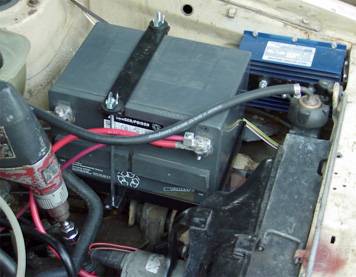 Monday, I dug into the 55 gallon barrel of high sulfur diesel that I have had stored out in the shed since filling up the Crown's fuel tank. I pumped about 4 gallons into a container, and refilled the plastic fuel container on the pusher. I've burned something like six gallons while fooling around trying to get it started, running it in the driveway, and now, powering the EV down the highway. The next aspect of this project will be to get the real fuel tank out of the remainder of the car and get it mounted in the pusher.
Monday, I dug into the 55 gallon barrel of high sulfur diesel that I have had stored out in the shed since filling up the Crown's fuel tank. I pumped about 4 gallons into a container, and refilled the plastic fuel container on the pusher. I've burned something like six gallons while fooling around trying to get it started, running it in the driveway, and now, powering the EV down the highway. The next aspect of this project will be to get the real fuel tank out of the remainder of the car and get it mounted in the pusher.
Here's a photo of the battery bracket and isolator (the blue heat sink in the rear). Oh Damn! You mean to tell me that the terminals and caps are supposed to be on top of the battery???? Relax, it's a gel-cell (sealed battery), no leaks, no maintenance, and it will only fit under the hood if it's mounted on it's side.

Half Rabbit goes wheelie!
Apr. 11th. After an afternoon of groveling on the dirt, I'm one fuel tank closer to disposing of the rest of the car. The tank (in the foreground, in front of the yellow-and-red fuel container), had no less than six hoses connected to it and I had to unbolt the rear axle to get it completely free of the body. It's kind of oddly shaped, with contours in the top the shape of a seat bottom, as that's exactly what was pressed against it from the inside of the car, the rear seat.
Also today, I installed a 0-30 psi pressure gauge on the expansion tank of the cooling system to see if I could figure out what's going on there. The gauge goes right up to 20 psi, where the pressure cap starts venting, after only a minute of engine operation, hot or cold. Not sure if this is normal, an indication of leakage from the cylinders, evidence of cavitation, or what. Maybe it's time to fire off an e-mail to the VW Diesel Tech Help guys and get an expert opinion. I do know that after shutting down the engine, it will hold 15 psi of pressure for hours afterwards, so how much of a leak inside the engine could there be? Also there is no contamination of the coolant, no soot, oily residue, etc., so I'm leaning towards cavitation, the formation of gas bubbles due to engine vibration and mineral deposits.
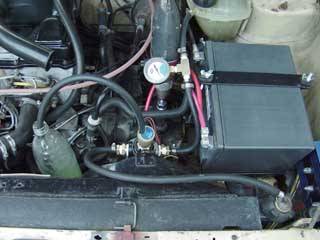 Well, the VW Tech Help guys thought that I had either a bad head gasket, or a cracked head, so this is a problem in search of a Band-Aid. April 14th. This image of underhood spaghetti is my temporary, half-assed solution to the air-in-the-coolant problem. Air and coolant mixed comes out of the top of the radiator at bottom right, goes into a ¾" Tee, where the flow slows down due to the enlarged passageway, and the bubbles rise to the top, to be vented out via the vent valve (blue top). Coolant, sans air, is returned to the cooling system expansion tank, while the air (still mixed with a small amount of coolant) goes into the bottle. Actually, the bottle has since been replaced by the windshield washer reservoir, which is handy, because I can use the built-in electric pump to return the accumulated coolant to the expansion tank. Top center is the 0-30 psi gauge, that I'm leaving in to check on the system pressure.
Well, the VW Tech Help guys thought that I had either a bad head gasket, or a cracked head, so this is a problem in search of a Band-Aid. April 14th. This image of underhood spaghetti is my temporary, half-assed solution to the air-in-the-coolant problem. Air and coolant mixed comes out of the top of the radiator at bottom right, goes into a ¾" Tee, where the flow slows down due to the enlarged passageway, and the bubbles rise to the top, to be vented out via the vent valve (blue top). Coolant, sans air, is returned to the cooling system expansion tank, while the air (still mixed with a small amount of coolant) goes into the bottle. Actually, the bottle has since been replaced by the windshield washer reservoir, which is handy, because I can use the built-in electric pump to return the accumulated coolant to the expansion tank. Top center is the 0-30 psi gauge, that I'm leaving in to check on the system pressure.
On a 27 mile test run today, I lost no coolant on the road, it all went into the reservoir. The system pressure was occasionally higher than I like to see (25 lbs), but the engine isn't overheating, and I am recovering all of the antifreeze, so it looks like this patch-job is a success.
Monday, I'll find out if I can get possession of a 1.6 liter diesel short block that I found outside the automotive technology shop at a local institute of higher learning. The engine was covered with dirt and grass clippings, and looks to be abandoned. If I can get it, I'll probably rebuild it instead of the engine I have now, because if the head on this engine is bad, I just want to start from scratch and do a complete and proper rebuild.
 Welcome to Sharkey's Chop Shop. Easter Sunday. This is what remains of the rear of the car this afternoon. Morning, I cleaned up the exterior of the fuel tank and test fitted it into the trailer. This got me to thinking about what parts and pieces I'd be able to use to make the sheet metal fabrication easier and more workman-like. It was difficult to imagine some of the relationships between the various parts without being able to measure them and hold them up together, so I decided to begin removing the parts I thought I'd need and getting rid of those I didn't. After spending some time figuring out the various bits of tubing going to the fuel filler and tank, the Sawzall was brought to life and the sectioning began in earnest. It's kind of scary how flimsy modern automobiles are. Do I really want to get up on the freeway in one of these and do 65 MPH??!!!
Welcome to Sharkey's Chop Shop. Easter Sunday. This is what remains of the rear of the car this afternoon. Morning, I cleaned up the exterior of the fuel tank and test fitted it into the trailer. This got me to thinking about what parts and pieces I'd be able to use to make the sheet metal fabrication easier and more workman-like. It was difficult to imagine some of the relationships between the various parts without being able to measure them and hold them up together, so I decided to begin removing the parts I thought I'd need and getting rid of those I didn't. After spending some time figuring out the various bits of tubing going to the fuel filler and tank, the Sawzall was brought to life and the sectioning began in earnest. It's kind of scary how flimsy modern automobiles are. Do I really want to get up on the freeway in one of these and do 65 MPH??!!!
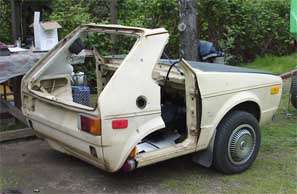 Very early in this project, I knew that the pusher would need a little styling enhancement. What I had in mind was a small spoiler or maybe a couple of vertical tail fins. This is the ultimate!!! A full Daytona-style airfoil wing!! Actually, I just haven't quite decided where to make the cut to remove the top of the hatch. It will be reconfigured to serve as a deck lid, and I need to make sure that I don't remove too much material when I top it. Otherwise, the rear is still way too long. About 24" will be cut off from what you see here to compact the back end. I should still have some room in the "trunk" for a couple of tool boxes or maybe a small cooler of refreshing beverages.
Very early in this project, I knew that the pusher would need a little styling enhancement. What I had in mind was a small spoiler or maybe a couple of vertical tail fins. This is the ultimate!!! A full Daytona-style airfoil wing!! Actually, I just haven't quite decided where to make the cut to remove the top of the hatch. It will be reconfigured to serve as a deck lid, and I need to make sure that I don't remove too much material when I top it. Otherwise, the rear is still way too long. About 24" will be cut off from what you see here to compact the back end. I should still have some room in the "trunk" for a couple of tool boxes or maybe a small cooler of refreshing beverages.
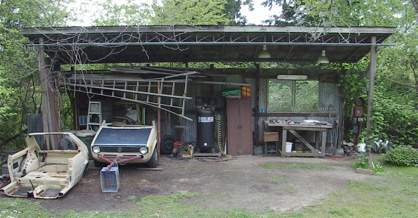
April 23rd, finally getting an update posted. Last week I was bitten by the Spring Cleaning bug, and got busy hauling a lot of useless junk out of the yard. A trip to the dump to haul away the winter's household garbage (two trash cans full, I recycle nearly everything else), and all of the broken glass, ratty wet carpet, and shattered plastic parts of the pusher body. While at the dump, I recycled all of the surplus steel, body panels, rear axle, and other sundry ferrous metals from the pusher. A trip to the wood products recycle yard eliminated about a ton of rotted dimensional lumber and all of the bark and duff from last winter's firewood. The local battery distributor paid me $13.50 for 1,200 pounds of dead lead acid batteries that had been stacking up for almost a year.
Friday, I got busy and began a project that has been needed for six years or so, building a rear wall into the work shed, using corrugated aluminum that I had in a stack just for that purpose. Now I can use the space along the back wall for my work bench, metal closet filled with extension cords, etc, air compressor and other stuff without having to cover it all with plastic to keep the rain off. The wall also gives me a new level of privacy from my sociopathic, nosey-old-bat of a neighbor, and helps keep much of my tool noise from invading the rest of the neighborhood, not that I really care about that too much. Sometimes it must sound like a boiler factory up here on the hill. Still to come is a 5' extension off of he left hand side of the shed to house the air compressor, trash cans and the big drum of diesel fuel, freeing up still more space for projects. As you see above, the Pusher is now securely under a roof, and needs no plastic or tarps for protection from the weather. I also now have at least a little bit of area in which to work that is sheltered from rain and direct wind and sun.
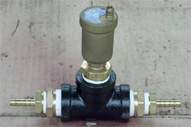

Saturday, I constructed a new air/coolant separator device. The old unit is on the left, and has been replaced by the new, more efficient design on the right. Longer tubing allows the air bubbles to float to the top of the flow of coolant, and the vertical runs of tubing at the "T" junctions allow the air to rise up, filling the top tubing, and then being expelled through the vent valve at the top. This device is mounted in front of the radiator, which was about the only long, unobstructed area I could find in the engine compartment. The bonus is that it's location in the airflow through the grille helps to cool the antifreeze mixture and might even have a beneficial effect on the separation process.
Greg came over today for a test run with the Pusher. We did a round trip out to Fern Ridge Reservoir, stopping on the way to weigh the car and Pusher at the County scales on Clear Lake Road. The EV still weighs 3,100 pounds, and now I know that the pusher tips the scale at 1,100. Multiple stops to check the engine and coolant pressure revealed that the system is running about 8 pounds of pressure. The coolant recovery tank was about half-filled on the way out (about 16 miles), but gained almost no additional fluid on the return trip (???). I'm still on the learning curve about this cooling system. Maybe it's getting time to take a 50 mile trip up to Lebanon to work for some clients, and see what happens on an extended trip.
Before that, though, I'll be installing the 18 new Trojan T-105 batteries in the EV. I can't see any reason to be hauling around a half-ton of batteries that only put out a couple of hundred pounds worth of power. New cells should make the EV much more long-lived and give me better acceleration. Besides, if I'm going to get very far from home, I want the ability to run the car to the end of it's range in case the Pusher konks out in the middle of rural timbuktu.
Not pictured here is my huge swollen left foot, which I managed to nearly impale on the end of a crowbar while attempting to unseat the bead on one of the old VW rims while removing the tire for disposal. It'll be interesting to see if I can walk in the morning....
Original material ©1996-2025 Mr. Sharkey | All rights reserved
